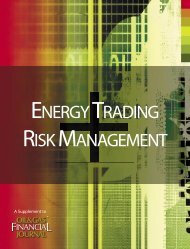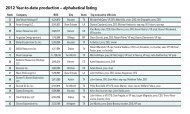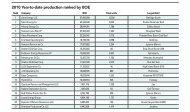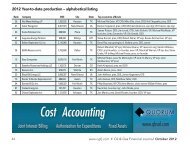energy trading risk management - Oil & Gas Financial Journal
energy trading risk management - Oil & Gas Financial Journal
energy trading risk management - Oil & Gas Financial Journal
Create successful ePaper yourself
Turn your PDF publications into a flip-book with our unique Google optimized e-Paper software.
+<br />
ENERGY TRADING<br />
RISK MANAGEMENT<br />
A Supplement to<br />
November 2011<br />
®
Buy vs. build: On reinventing<br />
the ETRM wheel<br />
Larry Hickey, FRM, Sapient, London<br />
Take a close look at your paycheck. Note that you’re not<br />
actually paid by the company you work for. You’re probably<br />
paid by a payroll processing company, perhaps ADP<br />
which pays 1/6th of all working Americans. Your company has<br />
outsourced the payroll function.<br />
Payroll is critically important and involves highly sensitive<br />
data. But <strong>management</strong> recognized that your company has no<br />
comparative advantage in the provision of payroll services. So<br />
the function was outsourced to a payroll company which can<br />
provide the service securely, reliably, and cheaply.<br />
“Securely” and “reliably” because payroll companies have<br />
developed specialized expertise in this area. They have a<br />
comparative advantage in the provision of payroll services.<br />
“Cheaply” due to economies of scale. The incremental cost of<br />
servicing another company is far less than it would cost your<br />
company to do it itself. Adam Smith would be proud.<br />
If your company’s do-it-yourself ethos extends to issuing paychecks,<br />
you can probably stop reading at this point. And good<br />
luck with your ETRM build!<br />
The same considerations come into play when a company<br />
decides whether to buy a commercially available ETRM solution<br />
or attempt to build one from scratch.<br />
First and foremost, the company must make a sober determination<br />
if the ETRM system is a competitive differentiator. Is the<br />
way you handle your portfolio over its lifecycle so different from<br />
the competition that it is part of your firm’s competitive advantage?<br />
This is a high hurdle for a number of reasons.<br />
What we do here is completely different. Really? By virtue of<br />
all trades having counterparties, there is at least one other entity<br />
wrestling with the same issues. How are they solving them?<br />
Industry leading solutions provide full lifecycle support so the<br />
portfolio can be managed and optimized at the highest level<br />
www.ogfj.com ◆ November 2011 ◆ Energy Trading & Risk Management25
of aggregation. A single system handles multiple commodities,<br />
integrates physical and financial transactions, and takes positions<br />
from forwards through physical delivery. Certain analyses<br />
such as credit and VaR only have meaning at the highest level<br />
of aggregation. Reiner Musier, chief marketing officer at Allegro<br />
Development, describes this “single version of the truth” as a<br />
key motivation for new customers coming from spreadsheets or<br />
in-house systems they have outgrown.<br />
“Customers recognize that a patchwork quilt of point solutions<br />
is simply not scalable,” says Musier. “They can do better.”<br />
Ditto at OpenLink where Wolfgang Ferse, executive vice<br />
president for commodity and <strong>energy</strong> solutions, reports about<br />
10 instances over the past three years of oil companies that<br />
have outgrown in-house systems and are looking for a scalable,<br />
end-to-end system. So with end-to-end ETRM systems widely<br />
available, the need to roll up data from disparate point solutions<br />
is a weak argument for internal development.<br />
Furthermore, leading solutions are modular and support plugins.<br />
Let’s say your firm has a proprietary credit methodology that<br />
you believe is key to your profitability. But your deal capture,<br />
confirmations, <strong>risk</strong> analysis, position reporting, and invoicing are<br />
standard. You can quickly implement those specific modules to<br />
support your standard processes and then plug in your custom<br />
credit methodology.<br />
The same goes for option valuation. Customers frequently<br />
implement proprietary option models or smile logic. So, even<br />
the need for proprietary pricing models is not a valid argument<br />
for internal development.<br />
Against all odds, let’s assume your portfolio handling is a<br />
competitive differentiator. The next question to ask is whether<br />
systems development is your core competency. An internal build<br />
will require not only the time of development resources. If the<br />
project is to be successful, it will also require extensive input<br />
from the front, middle and back offices. Do you really have the<br />
skills and bandwidth necessary to develop an ETRM system<br />
from scratch? Is systems development the best use of those<br />
resources?<br />
Michael Schwartz, Triple Point Technology’s chief marketing<br />
officer, notes, “There is a particular danger if an internal<br />
development initiative isn’t business driven. Even if an organization<br />
has available IT staff, it doesn’t mean they have the skills or<br />
experience to build a highly functional commodity <strong>management</strong><br />
system…in fact, they almost never do.”<br />
It’s easy to underestimate the effort required to develop a<br />
capable system. Consider a case from over a decade ago in Germany<br />
where a coalition of large <strong>energy</strong> companies joined forces<br />
to develop an ETRM system. The idea was for the IT departments<br />
to work with a development group to produce a system<br />
that would compete with established vendors. But they grossly<br />
underestimated the cost of doing so. About four years and 100<br />
Mio DM later, the project was quietly abandoned.<br />
Wolfgang Ferse notes that OpenLink’s flagship product Endur<br />
is the culmination of “over 3,000 man-years of development and<br />
testing, with hundreds more going in every year.” That’s hard to<br />
replicate.<br />
The relative stability of the ETRM business is another signal<br />
that significant barriers to entry exist. OpenLink, Triple Point,<br />
SunGard, SolArc, and Allegro are the top five names in the<br />
space. The youngest company is 18 years old. Much larger<br />
names have tried and failed to enter the space.<br />
If companies that do internal builds do in fact have a comparative<br />
advantage in software development, one would think<br />
internally developed systems would be offered for sale alongside<br />
other commercial packages. But they aren’t.<br />
Just recently a major European <strong>energy</strong> company undertook a<br />
two-year analysis project to determine the feasibility of replacing<br />
a gaggle of third-party applications with internal development.<br />
In the end, the board decided that internal development was too<br />
<strong>risk</strong>y and that software development was not the company’s core<br />
competency. So they decided to license an enterprise solution to<br />
replace the legacy systems.<br />
In addition to developing, testing and deploying your new<br />
system, you will also need to fully document and conduct training<br />
on it.<br />
The facts on the ground<br />
Allegro recently did a survey of <strong>energy</strong> companies regarding<br />
ETRM systems. The company received more than 250 responses,<br />
three-fourths of which were from <strong>trading</strong>, <strong>risk</strong>, or finance departments.<br />
They found a roughly even three-way split between a<br />
commercial system, spreadsheets, and an in-house developed<br />
system to run their <strong>trading</strong> and <strong>risk</strong> <strong>management</strong> business.<br />
In 2010 Energy Risk reported on a poll with 190 valid<br />
responses where 54.7% described their software as mostly offthe-shelf<br />
with some in-house add-ons. 17.6% reported having<br />
mostly in-house build systems with some off-the-shelf. At the<br />
extremes, 17.1% reported using off-the-shelf software only and<br />
10.6% said their software was in-house company-developed<br />
software only.<br />
Both surveys have in-house development at roughly 30%.<br />
Is there any trend toward internal development?<br />
“No. There are always some companies analyzing or starting<br />
in-house initiatives. But the trend is in the other direction,” says<br />
Wolfgang Ferse. “Not only have commercial applications gained<br />
wide acceptance in the market, now we’re seeing a push towards<br />
outsourcing the hardware the applications run on as well.”<br />
So this discussion is framed in a meaningful way, let’s stipulate<br />
that ETRM implementations are complex undertakings that often<br />
involve a variety of systems. A 2003 survey found that 33% of the<br />
time a module of another system is used next to their main system.<br />
If the system of record at the center is a commercial system,<br />
that counts as a buy. If it’s an in-house system, that counts as a<br />
build.<br />
Let’s say there is a valid theoretical basis for an internal build<br />
and you actually succeed in developing the software. Will you be<br />
able to maintain it?<br />
Markets change. New regulatory requirements emerge. A key<br />
advantage of commercial packages is that the vendor is respon-<br />
26<br />
Energy Trading & Risk Management ◆ November 2011 ◆ www.ogfj.com
advertisement<br />
Allegro Trading & Risk<br />
Management Systems<br />
Optimize your business performance across commodities, business units,<br />
and all physical, financial, and logistics assets<br />
Allegro is a global provider of <strong>energy</strong> <strong>trading</strong> and <strong>risk</strong><br />
<strong>management</strong> software for power and gas utilities,<br />
refiners, producers, traders, and commodity consumers.<br />
The Allegro 8 platform drives profitability and efficiency<br />
across front, middle, and back offices, while managing the complex<br />
logistics associated with physical commodities such as crude<br />
oil, natural gas, refined products and coal.<br />
For 27 years, Allegro has been committed to providing<br />
advanced architecture, unique development and deployment<br />
approaches, and innovative products that closely align with<br />
customer business objectives. The company utilizes agile methodologies<br />
that allow rapid, industry-focused development and<br />
deployment of solutions to meet the needs of the market.<br />
Achieve Your Business<br />
Objectives With Allegro 8<br />
Allegro software and services help <strong>energy</strong> companies achieve<br />
their most important business objectives:<br />
• Improve Position Analysis and Valuation - Make better<br />
market decisions with accurate and instantaneous views of<br />
positions and valuation<br />
• Improve Trader Productivity - Streamline and automate<br />
trade processes to reduce the <strong>risk</strong> and cost of dual-entry and<br />
manual processes to allow maximum attention to profitable<br />
opportunities<br />
• Manage Market Price Exposure - Mitigate exposure to<br />
volatile market prices with effective hedging and real-time<br />
updates, comprehensive metrics, and simulation<br />
• Manage Counterparty Exposure - Mitigate exposure with<br />
credit and collateral <strong>management</strong>, and a flexible credit scoring<br />
process<br />
• Manage Liquidity Exposure - Manage cash and capital<br />
adequacy with efficiency<br />
• Achieve Hedge Accounting Compliance - Manage compliance<br />
with accuracy and confidence<br />
Allegro Delivers Award-Winning Software<br />
• Top Ranked as a “Leader” in IDC MarketScape: Worldwide<br />
Energy Trading and Risk Management 2011 Vendor<br />
Assessment<br />
• 2011 Leader’s Quadrant in Gartner report “Magic Quadrant<br />
for Energy Trading and Risk Management Platforms”<br />
• 2011 Energy Risk Software Survey: #1 in both Ease of Use<br />
& Customer Support<br />
Headquartered in Dallas, Texas, Allegro has offices in Calgary,<br />
Houston, London, Singapore and Zurich, along with a global<br />
network of partners.<br />
To contact a regional office directly, please call:<br />
Europe +44 (0) 22 99 020<br />
North America +1 888 239 6850<br />
Asia Pacific +65 6236 5730<br />
Email info@allegrodev.com<br />
www.allegrodev.com
sible for keeping abreast of changing regulatory and compliance<br />
requirements. This makes sense – one vendor instead of every<br />
<strong>energy</strong> company.<br />
This service comes at the cost of maintenance payments,<br />
which are also used to fund enhancements to the system. By<br />
this means, the insights and requirements of the client base are<br />
reflected in the system.<br />
Michael Schwartz notes that “Triple Point’s multi-commodity<br />
solution, CXL, is an evolving best practices platform. Clients with<br />
deep market expertise request enhancements and modifications.<br />
Triple Point responds and, in so doing, the product is continually<br />
improved to better fit the markets we serve. Although every<br />
client doesn’t request every improvement, everyone gets them.<br />
So our clients mutually benefit from each others’ enhancement<br />
ideas. The more clients, the more great ideas that wind up in the<br />
product.”<br />
OpenLink’s Endur fields enhancement requests from 15 of the<br />
top 25 <strong>energy</strong> and commodity <strong>trading</strong> firms by market capitalization.<br />
So, whereas internal development can only reflect the perceived<br />
needs of a small group, commercial applications leverage<br />
a much wider knowledge base.<br />
In addition to maintaining and enhancing the product,<br />
vendors also have to provide migration tools to move to new<br />
releases and from de-supported to supported technologies.<br />
Finally, let’s state the obvious. Commercial software can be<br />
implemented quickly. It is thoroughly tested and is cheaper. The<br />
economies of scale are undeniable.<br />
Reiner Musier notes that “With Allegro’s component based<br />
software and agile deployment methods, <strong>energy</strong> companies can<br />
complete focused projects and start realizing value in as little as<br />
four months.”<br />
In the “choose your poison” category, there is the issue of<br />
becoming dependent on the system provider. If you buy, you will<br />
be dependent on the vendor. That didn’t work out so well for<br />
customers on Contango when Vedaris failed in 2004. But failure<br />
among ETRM vendors is a rare occurrence. If you build, you will<br />
become hostage to…err, dependent on internal IT resources.<br />
There are negatives associated with off-the-shelf ETRM systems.<br />
Let’s address them.<br />
First of all, even if they’re cheaper than internal development<br />
over the lifecycle, licensing, and maintenance is expensive. Second,<br />
the software may require extensive customization to fully<br />
capture your business practices. This can blur the line between<br />
buying and building. You may investigate the business processes<br />
that drove the software to its current state and adapt accordingly<br />
or you may decide to choose a highly configurable application to<br />
support your processes as is. You will find that trying to shoehorn<br />
the last 5% of your requirements into the system can be prohibitively<br />
expensive. Finally, there is a wide perception that system<br />
tweaks are turned around faster on in-house systems. There are
some perks to having the development shop on site.<br />
It is perhaps for this last reason that users reported higher<br />
satisfaction with in-house systems in a 2003 satisfaction survey.<br />
In-house systems scored a 7.6 rating against a 5.7 for off-theshelf<br />
systems. The authors were unable to choose between two<br />
competing explanations.<br />
In-house systems are on average better than off-the-shelf<br />
systems because they better fulfill the needs of the user or users<br />
of in-house systems are ignorant of the alternative. Put simply, inhouse<br />
systems are on average not better or worse than systems<br />
of external suppliers, but the close involvement in its development<br />
gives users a good feeling about it.<br />
Seven years later, a 2010 survey confronted the issue head<br />
on. Respondents, who were mostly happy with their systems,<br />
were asked – if budget was not an issue – whether they would<br />
upgrade their existing system, buy a new system or build a new<br />
one. 54% choose upgrade. 33% would buy a new system, and<br />
less than 13% would build a new system. That’s 87% buy, 13%<br />
build.<br />
And that’s with the build enabling assumption that “budget<br />
was not an issue.” It turns out budget is an issue on this planet.<br />
Is it reasonable to assume that your IT shop is going to successfully<br />
deliver a capable system on budget, on deadline, and<br />
without you becoming a hostage to the developer? For the sake<br />
of argument and in the face of all experience, let’s assume the<br />
answer is “Yes.” Once developed, can the system evolve to meet<br />
new <strong>trading</strong> and regulatory requirements? Will it reflect anything<br />
more than the insights and requirements of a small group?<br />
On balance, the evidence in favor of buying is overwhelming.<br />
The comparative advantage and economies of scale enjoyed by<br />
vendors trounce claims of uniqueness. The facts, it would seem,<br />
have a pro-buy bias.<br />
Let’s address the elephant in the elevator. I have spent the<br />
past 13 years implementing commercial ETRM systems. So I<br />
can hardly feign objectivity on this issue. While this is true, I am<br />
highly confident that the facts bear me out. Like black swans and<br />
Bigfoot, I have heard of successful, large-scale, internal builds. I<br />
just haven’t seen one.<br />
On the other hand, details on failed efforts are readily available.<br />
The stakes can be high. With rumors that a billion-dollar<br />
implementation exists, it pays to get this decision right. How<br />
much sympathy will there be for the next <strong>management</strong> that lets<br />
hope triumph over experience?<br />
About the author<br />
Larry Hickey is a director with Sapient Global Markets<br />
and frequent contributor to these pages. He<br />
has spent the past 13 years implementing industry<br />
leading ETRM solutions, with a focus on the physical<br />
delivery of commodities.<br />
marcus evans North America 2012<br />
Risk Management Events<br />
“ marcus evans Banking, Finance and Insurance<br />
Divisions are the leading providers of the highest quality financial conferences. ”<br />
2012 Events Include:<br />
2nd Annual Chem Petrochem & Refinery Asset<br />
Management | January 24-26, 2012<br />
Past Speakers Include Leading Chem/Petrochem<br />
& Refinery Experts From:<br />
• Union Carbide Corporation<br />
• Sunoco Inc.<br />
• ERCO Worldwide<br />
• TPC Group<br />
4th Annual Chem Petrochem & Refinery Shutdowns<br />
and Turnarounds Conference | Aug 7-9, 2012<br />
Past Speakers Include Leading<br />
Shutdown/Turnaround Experts From:<br />
• The Dow Chemical Company<br />
• Flint Hills Resources<br />
• ConocoPhillips<br />
• ONEOK Hydrocarbon Southewest, LLC<br />
2nd Upstream <strong>Oil</strong> & <strong>Gas</strong> Contract Management<br />
February 22-24, 2012, Houston, TX<br />
Past Speakers Include Leading <strong>Oil</strong> and <strong>Gas</strong> Contract<br />
Management Experts From:<br />
• Parker Drilling Company<br />
• Hess Corporation<br />
• Baker Hughes Incorporated<br />
• BP<br />
5th Annual Risk Management in Energy Trading<br />
Conference | November 2012<br />
Past Speakers Include Risk Management Experts From:<br />
• Commodities Futures Trading Commission<br />
• Constellation Energy<br />
• Goldman Sachs<br />
• JPMorgan Credit Trading<br />
For More Information<br />
on the Events Listed<br />
Above, Please Email<br />
Michele Westergaard Here
Dodd-Frank compliance forces changes<br />
in CTRM vendor-provided capabilities<br />
Paul Campbell, Tom Lochbichler, and Simit Dhawan, Deloitte & Touche LLP, Houston<br />
The Dodd-Frank Wall Street Reform and Consumer Protection<br />
Act has stated goals of lowering <strong>risk</strong>, promoting transparency,<br />
and protecting the American public. Nonetheless,<br />
the impact of Dodd-Frank may not be fully understood for years.<br />
Certainly, the regulatory impact is likely to be different for the financial<br />
service industry (FSI) compared to the <strong>energy</strong> industry.<br />
While almost the full scope of Titles I – XVI of Dodd-Frank, as<br />
understood today, are applicable to large financial institutions,<br />
much of the focus has been on sections of Title VII pertaining to<br />
use of swaps and regulation by the Commodity Futures Trading<br />
Commission (CFTC) that will have the greatest impact on <strong>energy</strong><br />
companies. There is concern as to what the future holds for <strong>energy</strong><br />
and commodity companies dependent upon solutions provided<br />
by commodity transacting and <strong>risk</strong> <strong>management</strong> (CTRM) vendors<br />
– these are the systems that will contain the required data for Dodd-<br />
Frank compliance.<br />
As an industry, CTRM vendors have traditionally trailed those<br />
focused on FSI due to the larger, more progressive market that is<br />
also much more heavily regulated. It is this regulation and definition<br />
of compliance requirements that can be translated into functional<br />
requirements for industry participants. CTRM vendors have the<br />
added challenge of providing functionality to manage physical commodities<br />
and logistics, the complexities of which are unique.<br />
Deloitte has developed an informed view on the path forward<br />
based on the benefit of a CTRM practice established more than 15<br />
years ago and a broad view of the <strong>energy</strong> industry that emerges<br />
from serving more than 90% of the market. This informed perspective<br />
also comes from our understanding of the impact of regulatory<br />
change from our Tax and Enterprise Resource Planning (ERP)<br />
practices.<br />
We see a likely evolution in CTRM vendor-provided capabilities<br />
for Dodd-Frank compliance, which may follow the four stages and<br />
30<br />
Energy Trading & Risk Management ◆ November 2011 ◆ www.ogfj.com
Light up your<br />
bottom line.<br />
Manage <strong>risk</strong> and create value.<br />
Led by Chairman Gil Burciaga, Asset Risk Management (ARM) takes a<br />
dynamic approach to <strong>risk</strong> <strong>management</strong> by implementing strategies that<br />
not only provide protection but also create value as the market provides<br />
opportunity. We have been helping oil and gas producers make better<br />
strategic hedging decisions since 2004. ARM <strong>Gas</strong> Marketing focuses on<br />
physical assets in the natural gas market. ARM represents public and private<br />
companies and interacts with all major <strong>energy</strong> commodity counterparties.<br />
Each member of ARM’s senior <strong>management</strong> team has more than 20 years<br />
of experience in the <strong>energy</strong> industry. Our experience and deep knowledge<br />
of the market give us the ability to rapidly deliver custom solutions that<br />
meet your objectives; dynamic market opportunities; and reliable, costeffective<br />
gas marketing services.<br />
Hedge strategies | gas marketing<br />
Houston | CHiCago | PittsburgH<br />
Chris Croom, President<br />
Zach Lee, CEO<br />
281.655.3200<br />
www.asset-<strong>risk</strong>.com
timings outlined below. This view on CTRM vendor evolution is<br />
based on similar regulatory regime changes related to Sarbanes-<br />
Oxley (SOX), derivative accounting (FAS 133/ASC 815), and even<br />
more recent issues related to gas price reporting and “Shipper<br />
Must Have Title” .<br />
System capabilities for Dodd-Frank compliance over the next<br />
five years will likely progress from Ad-Hoc, to Fragmented, and<br />
then Comprehensive and Integrated. As the rules related to swap<br />
transacting, including issues like position limits, end-use exception,<br />
etc., have not yet been finalized by the CFTC, <strong>energy</strong> companies’<br />
response will similarly progress from stages that can be characterized<br />
as “Wait and See,” to “Maintain Awareness,” and then to<br />
“Proactively” addressing the combined business and technology<br />
solutions to meet compliance.<br />
Ad-Hoc<br />
While a small number of <strong>energy</strong> market participants are beginning<br />
to address their expected Dodd-Frank requirements, the majority of<br />
companies have been slow to make investment decisions regarding<br />
changes to their underlying CTRM systems and processes, given<br />
the high degree of uncertainty with respect to the final rules.<br />
Unlike the FSI industry, which has historically been more heavily<br />
regulated and is used to proactively responding to regulatory<br />
ambiguity, many <strong>energy</strong> companies have difficulty making investments<br />
or major decisions to address these issues until they become<br />
better understood. Similarly, CTRM vendors are unlikely to build<br />
functionality that addresses Dodd-Frank in any comprehensive manner<br />
thereby putting the burden on <strong>energy</strong> companies to develop<br />
internal ad-hoc solutions to meet their needs.<br />
As in the past with SOX and derivative accounting requirements,<br />
the initial response to be in compliance with Dodd-Frank for most<br />
companies will be to develop interim solutions using Microsoft<br />
Excel. Similarly, the related business processes will likely be highly<br />
manual and ad-hoc.<br />
In this environment, the challenge to build out these ad-hoc<br />
tools will be three-fold. First, from a data perspective, organizations<br />
will need to capture information not currently available in existing<br />
systems. Examples of this would include Dodd-Frank counterparty<br />
classification, obligation security method, and counterparty end-use<br />
exception election, as well as new internal deal classifications. There<br />
will also be an element of data cleansing so that the reported data<br />
is accurate. Companies that have transacting and counterparty<br />
information in numerous systems will have an especially large challenge<br />
with integrating and standardizing their data to meet these<br />
initial reporting requirements.<br />
Dodd-Frank reporting requirements will not only impact <strong>energy</strong><br />
companies’ <strong>trading</strong> functions but also likely the fuel procurement,<br />
treasury and regulated hedging functions. Therefore, these ad-hoc<br />
solutions and processes will impact a large number of personnel.<br />
Second, the data must be combined and transformed to correspond<br />
to Dodd-Frank reporting standards. Positions will need to<br />
be aggregated and classified, and new reporting views need to be<br />
developed which in many cases are currently not produced by companies<br />
today, and lack relevant business processes and controls.<br />
Third, mechanisms for internal as well as external distribution<br />
need to be developed. This includes the governance, responsibility,<br />
and accountability for approving information. This will include<br />
approval of some reports by the board and senior executives as<br />
defined by the CFTC. The standards that companies would likely<br />
apply to these reports will be similar to those required for external<br />
financial reporting.<br />
Internally, position limits, counterparty exposure, collateral,<br />
and <strong>trading</strong> behavior consistent with classification will need to be<br />
actively monitored and reported on. The standards that companies<br />
would likely apply to these reports will be similar to those required<br />
for normal operational reporting.<br />
Early on, for most companies that have not gone through Dodd-<br />
Frank preparatory projects, the focus will be on rapidly responding<br />
to the new requirements and will not be on developing sustainable<br />
processes and compensating controls. Given the high bar of complying<br />
with Dodd-Frank, companies cannot afford to stop there.<br />
This will lead them into the next stage of maturity.<br />
Fragmented<br />
In the short to medium term, Dodd-Frank rules will continue to<br />
be refined. Energy companies will need to work towards not only<br />
enhancing and automating their previously constructed tools and<br />
processes, but also towards integrating these into their commercial<br />
and regulatory reporting organizations.<br />
Dodd-Frank regulations will not stop at requiring merely periodic<br />
passive reporting. They will reach deeply into the business and<br />
will require an extremely high level of internal communication.<br />
For example, managing a counterparty’s Dodd-Frank designation<br />
will be an on-going process. Further, companies that are able to<br />
proactively integrate Dodd-Frank requirements into their <strong>trading</strong><br />
strategies will likely have a competitive advantage.<br />
At this stage it is unlikely that off-the-shelf solutions, from<br />
specialized niche vendors or traditional CTRM vendors, will be available.<br />
Therefore, <strong>energy</strong> companies will need to enhance their previously<br />
developed ad-hoc processes and tools for sustainability while<br />
incorporating a higher degree of automation and workflow capabilities.<br />
These tools and processes will be more closely integrated into<br />
the commercial organizations and, as learning is internalized, a set<br />
of industry best practices will be developed. Excel-based tools will<br />
give way to data repositories that are integrated and linked to existing<br />
CTRM solutions and other business systems. New data capture<br />
will be automated to a greater extent than before.<br />
Finally, commercial decisions will be strongly influenced be the<br />
Dodd-Frank reporting process. Energy companies will now be<br />
transitioning out of passively responding to an externally imposed<br />
reporting requirement, and into a stage where Dodd-Frank is<br />
becoming ingrained in their business. At the conclusion of this<br />
stage, a small number of niche vendors that have built custom solutions<br />
for <strong>energy</strong> companies for Dodd-Frank compliance tools may<br />
emerge.<br />
Comprehensive<br />
In the medium term, we expect that Dodd-Frank compliance<br />
32<br />
Energy Trading & Risk Management ◆ November 2011 ◆ www.ogfj.com
equirements will continue to mature and be revised to meet the<br />
regulators’ defined objectives. The associated reporting standards<br />
and related data requirements may continue to be impacted but to<br />
a lesser degree. However, <strong>energy</strong> companies will have a comprehensive<br />
view of the impact of Dodd-Frank on their organizations<br />
and will look to migrate their previously built tools and processes<br />
into enterprise systems.<br />
We expect that the <strong>energy</strong> industry will favor CTRM vendors that<br />
provide automated Dodd-Frank compliance monitoring and reporting<br />
capabilities. Stability in Dodd-Frank rules and client demands<br />
will likely push major CTRM vendors to make significant investments<br />
to meet these needs. To this end, leading CTRM vendors will begin<br />
to offer Dodd-Frank compliance modules that are built through a)<br />
internal development efforts, b) joint development programs with<br />
their new or existing clients, c) expert advice from external consulting<br />
firms, and/or d) acquisitions or partnering relationships with<br />
niche vendors.<br />
Historically, major CTRM vendors have used these strategies to<br />
build their capabilities to meet derivative accounting requirements.<br />
At this stage, <strong>energy</strong> companies may need to consider Dodd-Frank<br />
compliance capabilities of their CTRM vendors as they consider the<br />
continued use of these platforms.<br />
We expect leading CTRM vendors and a smaller number of<br />
niche vendors to be leaders in offering Dodd-Frank compliance<br />
solutions at this stage. We could also see major ERP vendors enter<br />
the solutions market related to compliance by providing this functionality<br />
as a part of their solution suite.<br />
Integrated<br />
In the long term, we expect the Dodd-Frank rules and compliance<br />
requirements to stabilize for all impacted companies, including<br />
<strong>energy</strong>. This stage will continue the evolutionary process of CTRM<br />
vendors enhancing automation, workflow, and reporting capabilities<br />
of their Dodd-Frank compliance modules/capabilities. Major ERP<br />
vendors, like SAP and Oracle, may make Dodd-Frank compliance a<br />
major focus of enhancing their capabilities using similar strategies<br />
used by CTRM vendors.<br />
Ultimately, ERP vendors may surpass CTRM vendor provided<br />
capabilities in this area. Recent history points to this trend where<br />
major ERP vendors have begun to offer robust governance, <strong>risk</strong>,<br />
and compliance (GRC) tools to automate SOX compliance. CTRM<br />
vendors have instead focused on expanding their capabilities<br />
to manage transactional and operational activities of multiple<br />
commodities and modes of transport. These vendors have not<br />
significantly enhanced their platforms to meet their client’s SOX<br />
compliance needs as these have evolved over the years. ERP vendors’<br />
integrated approach to Dodd-Frank compliance, by incorporating<br />
best practices from FSI and <strong>energy</strong> companies, could provide<br />
integrated and robust industry standard solutions.<br />
Conclusion<br />
Energy companies should not rely on their CTRM vendors to<br />
provide Dodd-Frank compliance capabilities in the short to<br />
medium term, nor should they wait for niche vendors to emerge<br />
in this timeframe. Given the uncertainty in Dodd-Frank compliance<br />
requirements, expected evolution of these rules, and the investment<br />
required by vendors to build out these capabilities, we expect<br />
that <strong>energy</strong> companies will have to bear the burden of building out<br />
these solutions and related business processes internally. Nonetheless,<br />
CTRM and ERP vendor solutions will emerge in the medium to<br />
long term.<br />
In conclusion, while some <strong>energy</strong> companies are waiting to see<br />
what the Dodd-Frank rules are before taking action, others are<br />
progressively moving towards maintaining awareness and understanding<br />
their potential impact. A smaller subset of companies are<br />
proactively addressing those impacts now.<br />
At a minimum, all <strong>energy</strong> companies should ensure that their<br />
technology and business leadership teams are aware of the potential<br />
impact on their systems and processes. They should actively<br />
consider Dodd-Frank compliance requirements as they plan to<br />
upgrade their existing systems or initiate implementation of new<br />
CTRM applications in the next 24 months. Additionally, they should<br />
put placeholders in their 2012 budgets to account for potential<br />
technology and process impacts due to these regulatory changes.<br />
Our previous experience of guiding <strong>energy</strong> companies through<br />
sweeping regulatory changes, especially <strong>trading</strong>, informs us that<br />
their total impact may be hard to discern but it is coming and, from<br />
a compliance standpoint, cannot be avoided.<br />
About the authors<br />
Paul Campbell is a leader of the Deloitte &<br />
Touche LLP’s Commodity Transacting and Risk<br />
Management practice and is also responsible<br />
for all Dodd-Frank services for <strong>energy</strong> companies.<br />
He brings both a business and technology<br />
background to solving <strong>risk</strong> <strong>management</strong> issues.<br />
Prior to joining Deloitte in 1999, he worked for<br />
a regulatory agency and several <strong>energy</strong> <strong>trading</strong><br />
companies.<br />
Tom Lochbichler is the leader of Deloitte’s Trading<br />
Technology practice, and has over 17 years of<br />
diverse experience delivering solutions across the<br />
<strong>Oil</strong> & <strong>Gas</strong> and Power & Utilities spaces. He has<br />
led numerous <strong>trading</strong> technology and regulatory<br />
projects at oil majors, including the design of a<br />
trade monitoring and surveillance platform, an<br />
assessment of a global regulatory compliance<br />
reporting platform, as well as a pilot of a communications<br />
surveillance application.<br />
Simit Dhawan is a senior manager with Deloitte<br />
and Touche LLP’s Energy and Resources practice.<br />
He is primarily focused on assisting his clients in<br />
designing and implementing transformational<br />
business and information technology solutions<br />
to manage and monitor <strong>risk</strong> around their <strong>trading</strong><br />
and relational operational activities.<br />
www.ogfj.com ◆ November 2011 ◆ Energy Trading & Risk Management33














